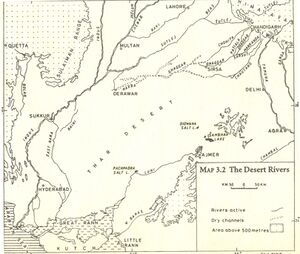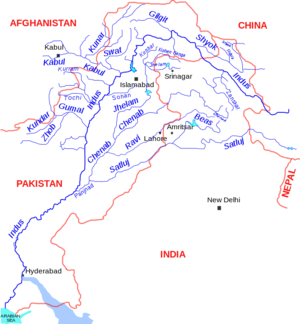Satluj River
| Author:Laxman Burdak, IFS (Retd.) |
Satluj River or Sutlej River (Hindi: सतलुज, Punjabi: ਸਤਲੁਜ, Urdu: درياۓ ستلُج ) is the longest of the five rivers that flow through the historic crossroads region of Punjab in northern India and Pakistan.
Variants of name
- Shatadru River शतद्रु = शतद्रू (AS, p.887)
- Shutudri शुतुद्रि = Shatadru शतद्रु (AS, p.905)
- Shatadru शतद्रु
- Satlej
- Satluj
- Satadree[1]
- Sydrus (Pliny.vi.21)
Location
It is located north of the Vindhya Range, south of the Hindu Kush segment of the Himalayas, and east of the Central Sulaiman Range in Pakistan.
Course
The Sutlej is sometimes known as the Red River. It is the easternmost tributary of the Indus River. Its source is Lake Rakshastal in Tibet. From there, under the Tibetan name Langqên Zangbo (Elephant River), it flows at first west-northwest for about 260 kms to the Shipki La pass, entering India in Himachal Pradesh state. It then turns slightly, heading west-southwest for about 360 kms to meet the Beas River near Makhu, Firozpur district, Punjab state.
Continuing west-southwest, the Sutlej enters Pakistan about 15 kms (9.3 mi) east of Bhedian Kalan, Kasur District, Punjab province, continuing southwest to water the ancient and historical former Bahawalpur princely state.
About 17 kms north of Uch Sharif, the Sutlej unites with the Chenab River, forming the Panjnad River, which finally flows into the Indus river about 100 kms west of the city of Bahawalpur. The area to the southeast on the Pakistani side of the Indian border is called the Cholistan Desert and, on the Indian side, the Thar Desert.
The Indus then flows through a gorge near Sukkur and the fertile plains region of Sindh, forming a large delta region between the border of Gujarat, India and Pakistan, finally terminating in the Arabian Sea near the port city of Karachi, Pakistan.
Mention by Pliny
Pliny[2] mentions 'The Nations of India.'....The remaining distances beyond the above point (Hypasis or Beas River) were ascertained on the expedition of Seleucus Nicator. They are, to the river Sydrus,23 one hundred and sixty-eight miles; to the river Jomanes, the same; some copies, however, add to this last distance five miles; thence to the Ganges, one hundred and twelve miles; to Rhodapha, five hundred and sixty-nine—though, according to some writers, this last distance is only three hundred and twenty-five miles; to the town of Calinipaxa,24 one hundred and sixty-seven, according to some, two hundred and sixty-five; thence to the confluence of the river Jomanes25 and Ganges, six hundred and twenty-five; most writers, however, add thirteen miles to this last distance; thence to the city of Palibothra,26 four hundred and twenty-five—and thence to the mouth of the Ganges, six hundred and thirty-seven miles and a half.
23 It does not appear that this river has been identified. In most of the editions it is called Hesidrus; but, as Sillig observes, there was a town of India, near the Indus, called Sydros, which probably received its name from this river.
24 It has been suggested that this place is the modern Kanouge, on the Ganges.
25 The modern Jumna. It must be borne in mind by the reader, that the numbers given in this Chapter vary considerably in the different MSS.
26 See the next Chapter.
History
The Upper Sutlej Valley was once known as the Garuda Valley by the Zhangzhung, the ancient civilization of western Tibet. The Garuda Valley was the centre of their empire, which stretched many miles into the nearby Himalayas. The Zhangzhung built a towering palace in the Upper Sutlej Valley called Kyunglung, the ruins of which still exist today near the village of Moincêr, southwest of Mount Kailash (Mount Ti-se). Eventually, the Zhangzhung were conquered by the Tibetan Empire.
The boundaries of Greater Nepal extended westward to beyond Satluj River until the tide turned in 1809 and Kangra king repulsed Gorkha army eastward with help from Maharaja Ranjit Singh (Punjab).
The Sutlej was the main medium of transportation for the kings of that time. In the early 18th century, it was used to transport devdar woods for Bilaspur district, Hamirpur district, and other places along the Sutlej's banks.
In Mahabharata
Shatadru River (शतद्रु) is mentioned in Mahabharata (II.9.19),(VI.10.14), (VIII.30.21), (VIII.30.35)
Sabha Parva, Mahabharata/Book II Chapter 9 mentions the Kings Oceans and the Rivers who attended Sabha of Varuna. Shatadru River (शतद्रु) is mentioned in Mahabharata (II.9.19).[3].....the Vipasha, the Shatadru, the Chandrabhaga, the Saraswati; the Iravati, the Vitasta, the Sindhu, the Devanadi;....
Bhisma Parva, Mahabharata/Book VI Chapter 10 describes geography and provinces of Bharatavarsha. Shatadru River (शतद्रु) is mentioned in Mahabharata (VI.10.14).[4].....and Shatadru, Chandrabhaga, the large river called Yamuna; of Dhrishadwati, and Vipapa, and Vipasha and Sthulabaluka; ....
Karna Parva/Mahabharata Book VIII Chapter 30 mentions the tribes who are not followers of Brahmanism. Shatadru River (शतद्रु) is mentioned in Mahabharata (VIII.30.21) and (VIII.30.35). [5]....Crossing the Shatadru and the delightful Iravati, and arriving at my own country, when shall I cast my eyes upon those beautiful women with thick frontal bones.......There where forests of Pilus stand, and those five rivers flow, viz., the Shatadru, the Vipasha, the Iravati, the Chandrabhaga, and the Vitasta and which have the Sindhu for their sixth, there in those regions removed from the Himavat, are the countries called by the name of the Arattas....
शतद्रु
शतद्रु (AS, p.887): विजयेन्द्र कुमार माथुर[6] ने लेख किया है ... शतद्रु अथवा शतद्रू पंजाब की सतलुज नदी का प्राचीन नाम। ऋग्वेद के नदीसूक्त मे इसे [p.888]: 'शुतुद्रि' कहा गया है- 'इमं मे गंगे यमुने सरस्वती शुतुद्रि स्तोमं सचता परुषण्या असिक्न्यामरुद्वृधे वितस्तयर्जीकीये शृणृह्या सुषोमया।' ऋग्वेद, नदीसूक्त 10,75,5. वैदिक काल में सरस्वती नदी शुतुद्रि में ही मिलती थी। (दे.मेकडानाल्ड- हिस्ट्री ऑफ संस्कृत लिट्रेचर, पृ. 142) परवर्ती साहित्य में इसका प्रचलित नाम 'शतद्रु' या 'शतद्रू' (सौ शाखाओं वाली) है। हिन्दू पौराणिक ग्रंथ वाल्मीकि रामायण में केकय से अयोध्या आते समय दशरथ पुत्र भरत के शतद्रु नदी को पार करने का वर्णन है- 'ह्लादिनीं दूरपारां च प्रत्यक् स्रोतस्तरंगिणीम् शतद्रुमतस्छीमान्नदीभिक्ष्वाकुनन्दनः।' वाल्मीकि रामायण, अयोध्या काण्ड 71,2. अर्थात "इक्ष्वाकुनन्दन भरत ने प्रसन्नता प्रदान करने वाली, चौड़े पाट वाली और पश्चिम की ओर बहने वाली नदी शतद्रु पार की।"
महाभारत, भीष्मपर्व 9,15 में पंजाब की अन्य नदियों के साथ ही शतद्रु का भी उल्लेख है- 'शतद्रुंचन्द्रभागां च यमुनां च महानदीम्, दृषद्वतीं विपाशां च विपांप स्थूलवालुकाम्।' श्रीमद्भागवत 5,18,18 में इसका 'चन्द्रभागा' तथा 'परुद्वृधा' आदि के साथ उल्लेख है- 'सुषोमा शतद्रूश्चन्द्रभागामरुद्वुधा वितस्ता।'
'विष्णुपुराण' 2,3,10 में शतद्रु को हिमवान पर्वत से निस्सृत कहा गया है- 'शतद्रुचन्द्रभागाद्या हिमवत्पादनिर्गताः।'
वास्तव में सतलुज का स्रोत रावणह्रद नामक झील है, जो मानसरोवर के पश्चिम मे है। वर्तमान समय में सतलुज 'बियास' (विपाशा) में मिलती है। किंतु ‘द मिहरान ऑफ सिंध एंड इट्रज ट्रिब्यूटेरीज’ के लेखक रेबर्टी का मत है कि 1790 ई. के पहले सतलुज, बियास में नहीं मिलती थी। इस वर्ष बियास और सतलुज दोनों के मार्ग बदल गये और वे सन्निकट आकर मिल गईं। शतद्रु वैदिक 'शुतुद्रि' का रूपांतरण है तथा इसका अर्थ "शत धाराओं वाली नदी" किया जा सकता है, जिससे इसकी अनेक उपनदियों का अस्तित्व इंगित होता है। ग्रीक लेखकों ने सतलुज को 'हेजीड्रेस' (Hesidrus) कहा है; किंतु इनके ग्रंथों मे इस नदी का उल्लेख बहुत कम आया है, क्योंकि अलक्षेंद्र (सिकंदर) की सेनायें बियास नदी से ही वापस चली गई थीं और उन्हें बियास के पूर्व में स्थित देश की जानकारी बहुत थोड़ी हो सकी थी।
References
- ↑ Asiatic Society of Bengal. Journal of the Asiatic Society of Bengal, Volume 17, Part 1. p. 210, paragraph two.
- ↑ Natural History by Pliny Book VI/Chapter 21
- ↑ विपाशा च शतद्रुश च चन्द्रभागा सरस्वती, इरावती वितस्ता च सिन्धुर देव नदस तदा (II.9.19)
- ↑ शतद्रुं चनद्रभागां च यमुनां च महानदीम, दृषद्वतीं विपाशां च विपापां सदूलवालुकाम (VI.10.14)
- ↑ शतद्रुक नदीं तीर्त्वा तां च रम्याम इरावतीम, गत्वा स्वदेशं द्रक्ष्यामि सदूलशङ्खाः शुभाः सत्रियः (VIII.30.21) पञ्च नद्यॊ वहन्त्य एता यत्र पीलु वनान्य अपि, शतद्रुश च विपाशा च तृतीयेरावती तदा, चन्थ्र भागा वितस्ता च सिन्धुषष्ठा बहिर गताः
- ↑ Aitihasik Sthanavali by Vijayendra Kumar Mathur, p.887-888
Back to Rivers/Rivers in Pakistan

